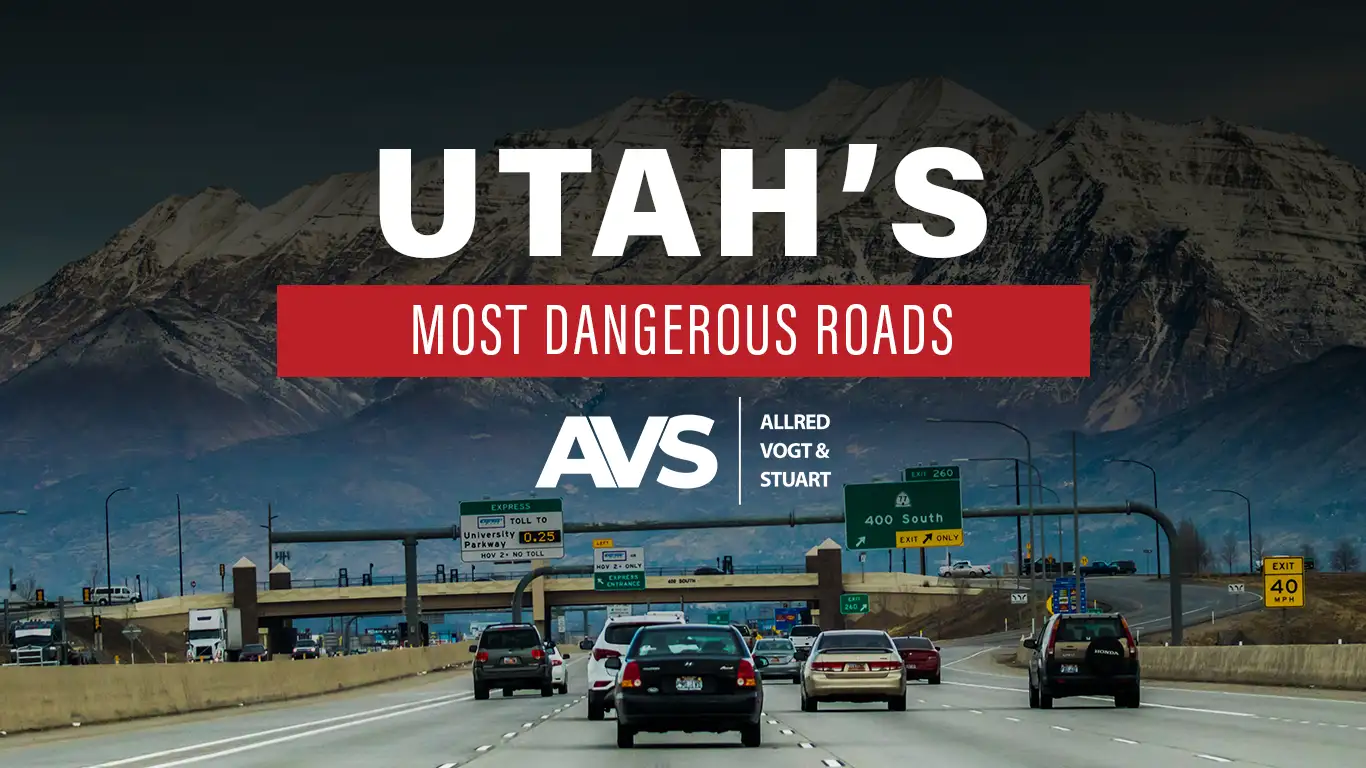Utah boasts some of America’s most breathtaking scenic drives, but beauty comes with risk. Despite the state’s reputation for well-maintained highways, Utah Department of Transportation (UDOT) and Department of Public Safety recent data shows 281 traffic deaths in 2024. Speeding contributed to a quarter of all fatal crashes, while over a third of fatalities involved impaired driving. Understanding where accidents occur most frequently can help Utah drivers stay safe and know their legal options if the unexpected happens and they need a car accident lawyer.
“Every crash death has a huge impact on our society,” says Colonel Michael Rapich of the Utah Highway Patrol. While driver error causes many accidents, some Utah roads present inherent dangers that increase crash risk significantly.
1. Interstate 15: Utah’s Deadliest Highway
Why I-15 is Utah’s Most Dangerous Road
Interstate 15 tops our list of Utah’s most dangerous roads, stretching north-to-south through the state’s most populated corridors including Ogden, Salt Lake City, Provo, and St. George. This heavily-trafficked interstate sees thousands of car accidents annually, making it a major concern for drivers.
I-15 Accident Risk Factors:
- 75 mph speed limit increases crash severity
- Limited visibility from large commercial vehicles
- Chronic traffic congestion leads to rear-end collisions
- Ongoing construction zones create hazardous conditions
As Utah’s population grows, I-15 traffic continues increasing without corresponding highway expansion, creating dangerous conditions for daily commuters and long-distance travelers alike.
2. Highway 6: Utah’s Rural Death Trap
Highway 6 Accident Statistics
Highway 6 ranks among America’s most dangerous rural highways according to NPR. Since 1996, this 60-mile stretch between Spanish Fork and Price has witnessed over 150 fatal accidents and 500 serious crashes. The winding canyon route presents unique dangers for Utah drivers.
Highway 6 Risk Factors:
- Narrow lanes increase side-swipe accident risk
- High-speed curves through canyon terrain
- Heavy truck traffic between Salt Lake City and Denver
- Limited passing zones lead to head-on collisions
- No median barriers in Spanish Fork Canyon section
Many Highway 6 fatalities occur when drivers attempt unsafe passing maneuvers, crossing into oncoming traffic with devastating results. This route is particularly dangerous due to its narrow, curving path through Spanish Fork Canyon without protective median barriers. Truck accident lawyers frequently handle cases from this treacherous route due to heavy commercial traffic.
3. Interstate 70: Scenic but Deadly
I-70 Utah Accident Dangers
Interstate 70’s Utah portion presents unique challenges as one of few major highways avoiding cities entirely. This 100-mile stretch between Green River and Salina has earned its place among Utah’s most dangerous roads due to isolation and challenging terrain.
I-70 Risk Factors:
- Zero services for 100+ miles between towns
- 7,886-foot elevation creates weather hazards
- Sharp curves through Spotted Wolf Canyon
- Driver fatigue from monotonous desert stretches
The combination of high elevation, remote location, and challenging weather conditions makes I-70 particularly dangerous for unprepared drivers, leading to serious accidents.
4. Ogden Canyon: 2024’s Safety Crisis Location
Recent Safety Concerns in Ogden Canyon
Ogden Canyon experienced severe incidents in 2024, prompting UDOT to implement emergency safety measures including truck bans and reduced speed limits. This scenic route has become increasingly dangerous as traffic volumes exceed the canyon road’s original design capacity.
Ogden Canyon Risk Factors:
- Narrow roadway with limited escape routes
- Sharp curves and steep grades
- Heavy recreational traffic during peak seasons
- Recent truck restrictions due to safety incidents
The 2024 safety crisis in Ogden Canyon demonstrates how quickly road conditions can deteriorate, requiring immediate legal attention for accident victims.
5. Washington Boulevard (SR 235): Ogden’s Urban Danger Zone
Washington Boulevard’s Most Accident-Prone Street
Washington Boulevard (State Route 235) continues to be identified as a heightened-risk roadway, with consistent accident rates that have plagued Utah Department of Transportation officials. This busy Ogden thoroughfare poses risks to both motorists and pedestrians in Weber County’s growing business district.
Washington Boulevard Risk Factors:
- Dangerous pedestrian crosswalks
- Only two lanes handling heavy traffic volume
- Weber County’s busiest commuter route
- Poor visibility for left-turn maneuvers
- High-speed tailgating incidents
Local residents have petitioned UDOT for additional safety measures, including improved lighting and crosswalk signals at high-risk intersections.
5. Interstate 80: Transcontinental Hazards
I-80 Utah Accident Statistics
Interstate 80 ranks third statewide for traffic fatalities, presenting coast-to-coast travelers with Utah-specific dangers. This transcontinental highway, constructed in 1956, carries significant risks through Utah’s challenging terrain and weather conditions.
I-80 Risk Factors:
- Complex “spaghetti bowl” interchange in Salt Lake City
- Severe winter weather conditions in Parley’s Canyon
- Wildlife migration crossing zones
- High-speed limit enforcement challenges
Parley’s Canyon, part of the I-80 corridor, represents one of Utah’s highest-risk canyon routes with frequent accidents due to steep grades and rapidly changing weather conditions. UDOT has installed emergency stopping signs and wildlife fencing to reduce I-80 accidents, but this remains one of Utah’s most dangerous highways for serious crashes.
Utah’s 2024 Traffic Safety: Key Contributing Factors
- Speeding: Contributing factor in 25% of all fatal crashes
- Impaired Driving: Over one-third of fatalities linked to alcohol and drug use
- Aggressive Driving: 23 deaths directly tied to road rage and aggressive behavior
- Vulnerable Road Users: Increased fatalities among motorcyclists, pedestrians, and bicyclists
Utah’s dangerous roads pose particular risks to motorcycle accident victims, pedestrians, and cyclists who lack the protection of enclosed vehicles.
UDOT’s Zero Fatalities Program
Utah’s Department of Transportation, working with the Department of Public Safety, has launched the Zero Fatalities program offering resources and statistics on crash prevention. This initiative specifically targets the leading causes of fatal accidents across Utah’s most dangerous roadways.
Utah Car Accident Lawyers – Serving Salt Lake City, Ogden, Provo & Statewide
Accidents happen in an instant, but their consequences can last a lifetime. Understanding Utah’s most dangerous roadways can help you stay safer, but when the unexpected occurs, you need experienced legal advocates on your side.
At AVS Law Group, we understand that being injured in a car accident turns your world upside down. You’re dealing with medical bills, lost wages, insurance companies, and trying to recover from your injuries. That’s where we come in. As your dedicated advocates, our job is to handle the legal complexities while you focus on healing.
We know Utah’s roads and the unique challenges they present. From I-15’s deadly stretches to the treacherous curves of Highway 6, we’ve successfully represented accident victims throughout the state. Our experienced team has taken thousands of cases to litigation and recovered significant settlements for our clients. We fight tirelessly to ensure you receive the full compensation you deserve for medical expenses, lost income, pain and suffering, and other damages.
Call us at (801) 876-7771 or contact us HERE – we’re ready to fight for you.
Time limits apply to Utah personal injury claims. Contact our experienced Utah car accident lawyers today to protect your rights and secure the compensation you deserve.


